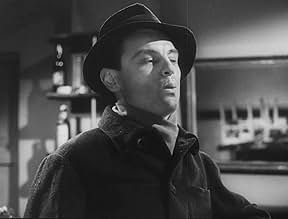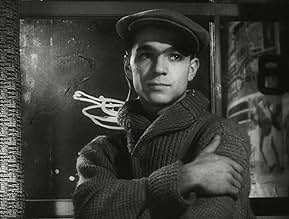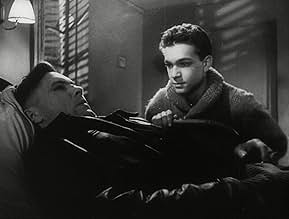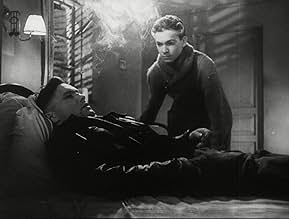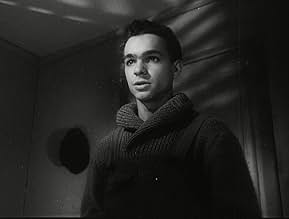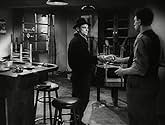Ubiytsy
- 1956
- 19min
VALUTAZIONE IMDb
6,5/10
3926
LA TUA VALUTAZIONE
Aggiungi una trama nella tua linguaTwo men besiege a lunch bar looking for a third man they must kill.Two men besiege a lunch bar looking for a third man they must kill.Two men besiege a lunch bar looking for a third man they must kill.
- Regia
- Sceneggiatura
- Star
Yuliy Fayt
- Nick Adams
- (as Yuli Fayt)
Ermengeld Konovalov
- Sam
- (non citato nei titoli originali)
Recensioni in evidenza
This film is interesting for being what it is--a Soviet cinema school's student project depicting a Hemingway short story--one of the student performers being Andrei Tarkovsky. As a film on its own right, its acting and direction are uneven. That said, I thought some of the acting was fine. The mood is a bit too subdued and less menacing than the story as I remember it. Then again, the cast were all close to 20--so that's probably is to be expected. According to most accounts, this was the first project from the Soviet film school portraying a non Russian story--and this choice, which was freshly published at the time was chosen by the young Tarkovsky himself, 4.5 stars out of 10
Although I did like the 1946 adaptation of the Killers, I wasn't sure how a Russian, let alone someone who is usually much more into the visual prowess of things like Andrei Tarkovsky, would tackle Ernest Hemingway's brief, pulpy story of men on a mission and a man in hiding from those men. Turns out it's one of the best short films I've seen from a soon-to-be world renown European auteur, because of it's emphasis on the simplicity of suspense, of human action in desperate circumstances and how it's filmed with a mix of the noir style and with Tarkovsky's dependence on figures in curiously exciting compositions. He isn't alone on the film, however, as the middle scene at the apartment was directed by friend Alexander Gordon, with Tarkovsky directing the bigger chunks at the diner, and another guy Marika Beiku co-directing overall. Since the apartment scene is so short though, and accounts for just three shots, one being most elaborate as it goes in and out, tight and wide, on the morose Swede in hiding and his friend at the diner filling him in on what happened, it's mostly Tarkovsky's game here.
Part of the skill, and curiosity, in how tense the long first scene at the diner is that music is completely absent, with the only tone coming from Tarkovsky himself as a whistling customer. Meanwhile, Tarkovsky uses Hemingway's dialog in a very realistic manner, even when he goes deliberate angles, like when George goes into the back with the sandwiches and we see his feet in the same tilted frame as an empty can on the floor, or with the usage of the mirror on the wall. There's also the suddenness of seeing a machine gun that strikes things up in the room, and just the general attitude of Al and Max, the hit men, as they keep calling George "bright boy" in a way that reminds me of the curious double-talk in a self-consciously bad-ass movie like Pulp Fiction (not to mention the near casual usage of the 'N' bomb). While it ends sort of on a screeching halt, the sense of ambiguity as to the fate of the Swede as well as everyone else in the diner who hid the secret is worthwhile for the material, as it's perfectly anti-climactic. It's not entirely a simple experiment, as it's too polished for that, but I couldn't see how it could be made any longer either. It's perfectly paced and acted nearly as well, and it's a fitting pre-cursor to the un-prolific but remarkable career of one of Russia's most important filmmakers.
Part of the skill, and curiosity, in how tense the long first scene at the diner is that music is completely absent, with the only tone coming from Tarkovsky himself as a whistling customer. Meanwhile, Tarkovsky uses Hemingway's dialog in a very realistic manner, even when he goes deliberate angles, like when George goes into the back with the sandwiches and we see his feet in the same tilted frame as an empty can on the floor, or with the usage of the mirror on the wall. There's also the suddenness of seeing a machine gun that strikes things up in the room, and just the general attitude of Al and Max, the hit men, as they keep calling George "bright boy" in a way that reminds me of the curious double-talk in a self-consciously bad-ass movie like Pulp Fiction (not to mention the near casual usage of the 'N' bomb). While it ends sort of on a screeching halt, the sense of ambiguity as to the fate of the Swede as well as everyone else in the diner who hid the secret is worthwhile for the material, as it's perfectly anti-climactic. It's not entirely a simple experiment, as it's too polished for that, but I couldn't see how it could be made any longer either. It's perfectly paced and acted nearly as well, and it's a fitting pre-cursor to the un-prolific but remarkable career of one of Russia's most important filmmakers.
This is the best student film I have ever seen. Not only in directing but style also. It's black and white as every good film noir is. If you can call this short film noir or not though is up for discussion. This is a very faithful adaption of Ernest Hemingway's short story The Killers. And the way it's shot, cut and acted is truly remarkable. Especially in one scene when a man walks into the diner while the killers have Nick Adams and the cook tied up in the back. The whole scene plays out without any dialogue but with the customer whistling a happy tune while George makes him his sandwich. A very good scene.
The short has no soundtrack and doesn't need one either. With the situation and the dialogue it all speaks for itself. A very good short and worth the money I payed for it.
The short has no soundtrack and doesn't need one either. With the situation and the dialogue it all speaks for itself. A very good short and worth the money I payed for it.
Pure genius, though a short, it sends out images of poetry and passion. Seeing an early stage of formation of majestic artistry will astonish all who sees this film. Rich and powerful, it is an element that sends emotions through all who experience this inspired film.
What the hell is that "Carnival of Colors" on Douban, the director of the 1935 film was Tarkovsky, born in 1932.
Tarkovsky's real nominal debutante is a far cry from the other master's earlier film, The Killer, which seems to have set a different style from the start. But this Tarkovsky without his later that the style of the scene shaping, on the contrary, quite a kind of Hollywood in that era of student work. But the audio-visual does have some aura, especially the fat man on the bed part especially has the style of Tarkovsky's kind of subtle mature dialogues.
The ending and some of the shaping is subtle, but not in Tarkovsky's style. Very strange lag, feels like 16 fps.
Tarkovsky's real nominal debutante is a far cry from the other master's earlier film, The Killer, which seems to have set a different style from the start. But this Tarkovsky without his later that the style of the scene shaping, on the contrary, quite a kind of Hollywood in that era of student work. But the audio-visual does have some aura, especially the fat man on the bed part especially has the style of Tarkovsky's kind of subtle mature dialogues.
The ending and some of the shaping is subtle, but not in Tarkovsky's style. Very strange lag, feels like 16 fps.
Lo sapevi?
- QuizAll the roles were played by students of the VGIK. Moreover, props were not only brought by students from their homes, but also provided from friends and relatives.
- ConnessioniFeatured in Une journée d'Andrei Arsenevitch (1987)
- Colonne sonoreLullaby of Birdland
Written by George Shearing
(1952)
Whistled by the second bar patron played by Andrei Tarkovsky
I più visti
Accedi per valutare e creare un elenco di titoli salvati per ottenere consigli personalizzati
Dettagli
- Tempo di esecuzione19 minuti
- Colore
- Mix di suoni
- Proporzioni
- 1.37 : 1
Contribuisci a questa pagina
Suggerisci una modifica o aggiungi i contenuti mancanti


